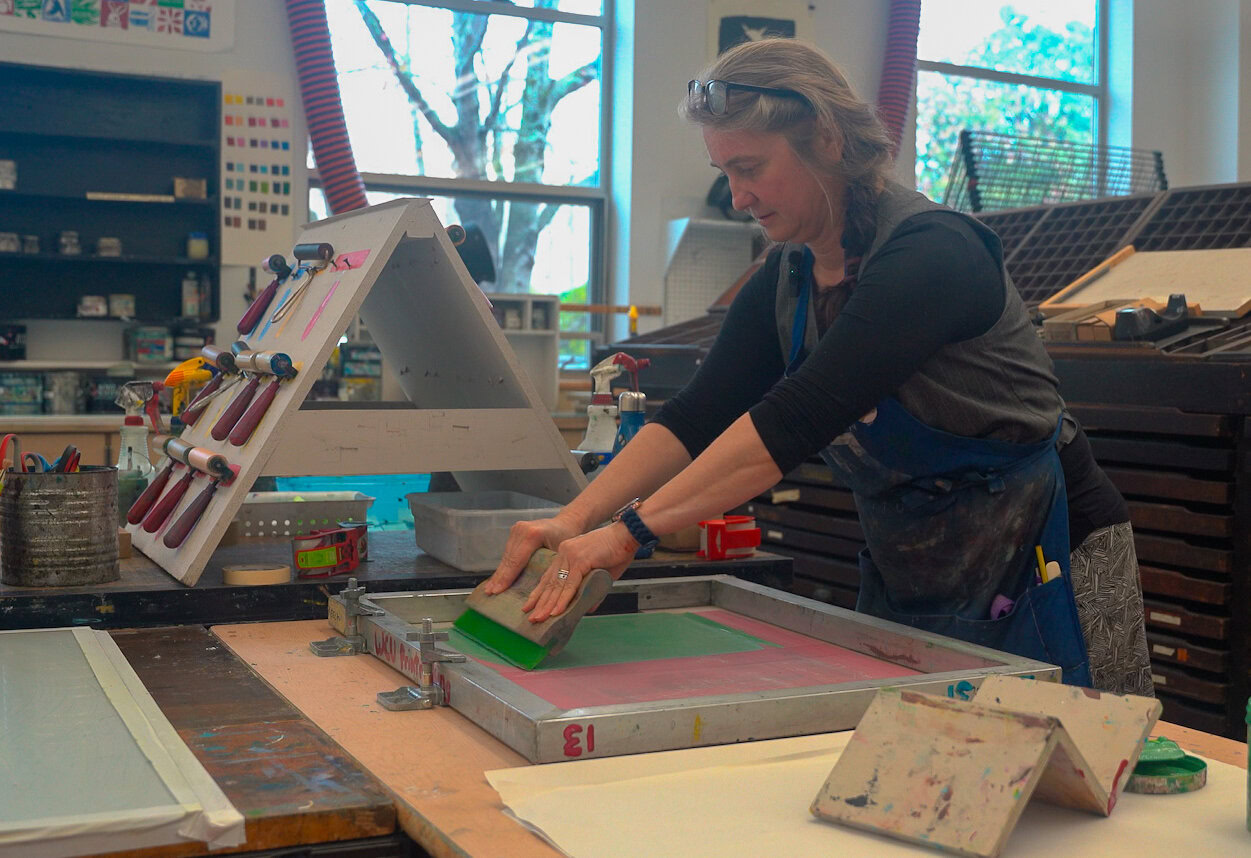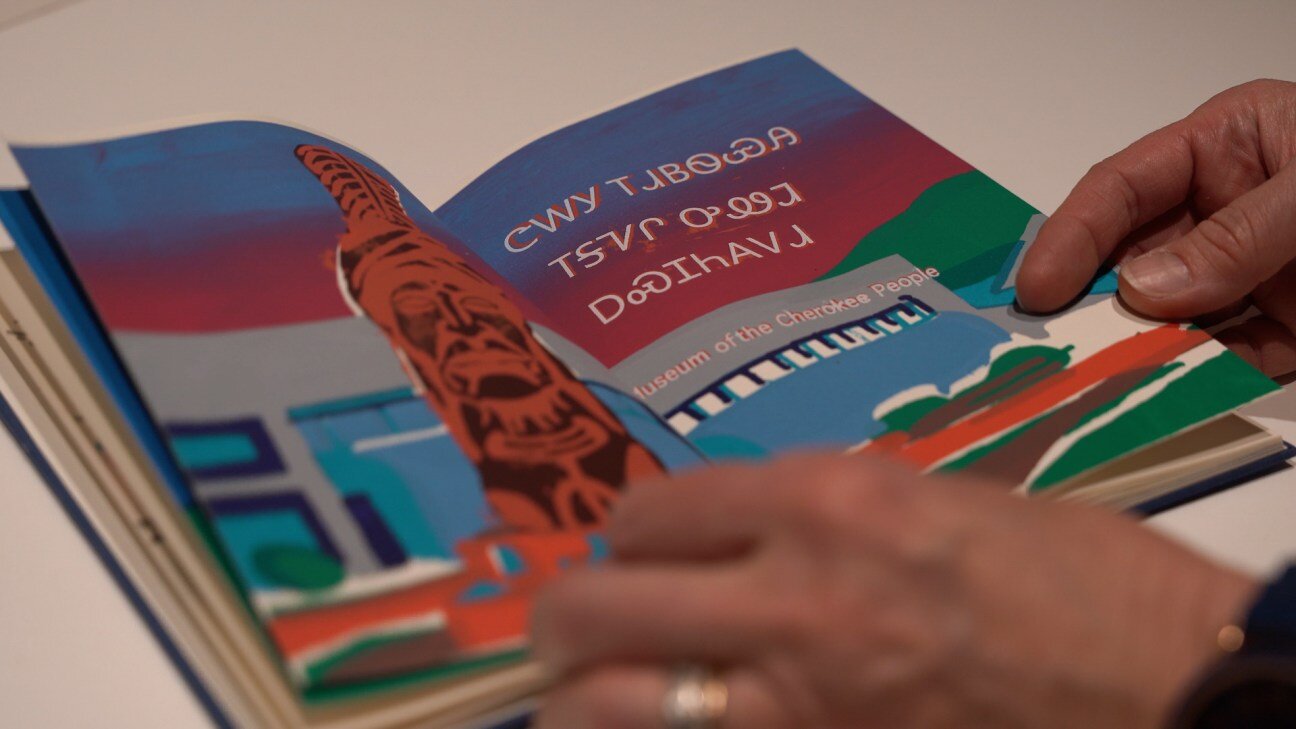This story was originally published in the Daily Yonder. For more rural reporting and small-town stories visit dailyyonder.com.
At the entrance to the New Kituwah Academy in Cherokee, North Carolina, a big red sign reads ‘English Stops Here.’ The school, which teaches preschool through the sixth grade, is a Cherokee language immersion program. Classes, lunch and after-school activities are conducted primarily in Cherokee, and the school’s books, maps and diagrams are full of the 85 symbols that make up the Cherokee syllabary.
Among other resources, teachers and students have access to copies of a half dozen hand-printed picture books designed and created by students at Western Carolina University (WCU). The books cover a range of topics, from Cherokee myths and legends to the riparian habitats of western North Carolina.
The partnership with WCU was initiated by Dr. Hartwell Francis, the curriculum developer for the New Kituwah Academy and an honorary member of the Eastern Band of Cherokee Indians.
“One of the things you realize when you start working with a language of a small population is that there are often no materials, or very few materials. And the materials aren’t very pretty,” Francis said in an interview with the Daily Yonder.
So Francis approached Tatiana Potts, printmaking and book arts professor at Western Carolina University. Potts, who is from Slovakia and grew up speaking multiple languages, embraced the project immediately. She sees it as an opportunity for her students to not only learn new printmaking skills, but also to build cross-cultural connections with a community only 20 miles down the road.
“The university is placed on former Cherokee land,” Potts told the Daily Yonder. “So I wanted that acknowledgement. Not just before every performance we do, but to make a real connection and learn about their culture.”
Guarding treasure
The New Kituwah Academy was created in 2005 as a measure to combat the loss of the Cherokee language.
“You can think of it as guarding treasure,” Francis said. “A language is a community’s greatest cultural creation, and it has all their wisdom packed into it in different ways.”
Though the Cherokee language has been spoken for thousands of years, it was considered critically endangered by the beginning of the 21st century. This was no accident — policies requiring Native American children to attend boarding schools through the mid-1900s were intended to force assimilation and weaken Indigenous cultural ties. Requiring that students speak English and punishing them for any use of their native language drastically reduced the number of Cherokee speakers in the community.
“There was a shift about 65 years ago, where people born before that grew up speaking Cherokee language, and people after that didn’t,” Francis said. “And so by 2005, the Eastern Band of Cherokee Indians realized their language was gravely endangered, with only adults over traditional childbearing age as speakers.”
Weighed down by negative news?
Our smart, bright, weekly newsletter is the uplift you’ve been looking for.
For the last 20 years, the Kituwah Preservation and Education Program has been revitalizing the Cherokee language by teaching it to new generations. The New Kituwah Academy teaches students from preschool through sixth grade, with the goal that students leave the school speaking the Cherokee language at an intermediate level.
Access to Cherokee-language learning materials is critical for the school’s immersion program. But such materials are not widely available, which has forced Francis and the school’s teachers to get creative. The solution — making their own materials — is one that is common among Indigenous language programs, according to Francis.

“In Native American language programs, you see people making their own materials. And it has to be that way to a certain extent because they are recreating their cultures after devastating loss.”
To make the books, Potts and her students meet with Francis and a program of adult Cherokee language learners, who decide the book topic and write the text in Cherokee syllabary each semester. The students submit sketches, which are critiqued by the Cherokee learners from a cultural perspective.
“Did they draw this creature in a Cherokee way? Does this resonate with the Cherokee culture? The students really take [the critiques] to heart. They appreciate the criticism and come back with much better work,” Francis said.
Potts said the project allows her printmaking students to engage in cultural research, and helps them be more analytical about their own worldviews.
“It makes them aware of ‘this is how I take things in, this is what I think is standard,’” Potts said. “And I see how that process changes when they do research, and how much they gain from that.”
Once the art is approved, the students screen print 10 copies of their sketches, each with a minimum of four color layers. Finally, Potts and a select group of students glue and bind those pages into 10 limited-edition books.

At the school, the books are used to support a range of subjects, from science and art to social studies. Because the books are hand-made with New Kituwah Cherokee learners in mind, the elementary-age students have a unique chance to see themselves and their community represented in their school materials.
For example, one book focused on the architecture of the Cherokee community includes important institutions like the school, museum, post office and local favorites like the restaurant Granny’s Kitchen and Santa’s Land Fun Park and Zoo.
“We can build connections [with the Cherokee community] through creating these images, and by making it beneficial for children and helping them be excited to maintain this language,” Potts said.
The project also sparks imagination and creativity among the elementary-aged students who use the books as class materials, Francis said. For example, seeing a college student’s rendition of the U’lag’û, a house-sized yellow jacket from Cherokee mythology, could prompt a third grader to respond with their own drawing.
“If you have a picture you can say, well that’s a nice giant hornet, but that’s not the kind of giant hornet I was thinking of,” said Francis. “And so these pictures will inspire [the kids] to artistic creation in the same way from their own cultural base.”
The books’ contents, as well as the language they are written in, support the critical mission of the New Kituwah Academy.
“There’s a cultural need to preserve the Cherokee language, and keep the poetry alive, the literature alive,” Francis said. “And to keep the interactions that happen in Cherokee language alive.”
This article first appeared on The Daily Yonder and is republished here under a Creative Commons Attribution-NoDerivatives 4.0 International License.![]()
PARSELY = { autotrack: false, onload: function() { PARSELY.beacon.trackPageView({ url: “https://dailyyonder.com/preserving-cherokee-language-ten-books-at-a-time/2025/04/25/”, urlref: window.location.href }); } }
The post Preserving Cherokee Language, 10 Books at a Time appeared first on Reasons to be Cheerful.




